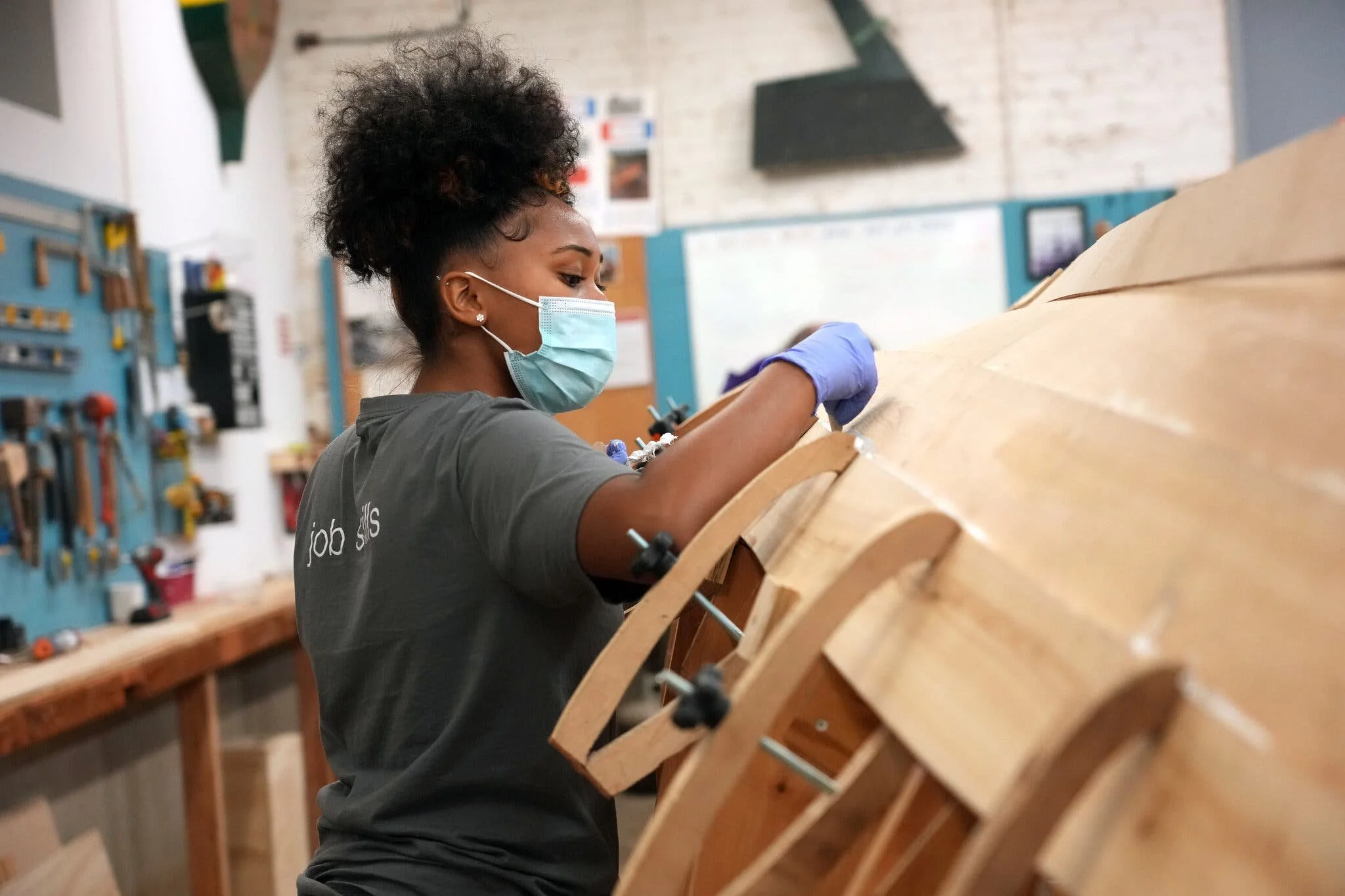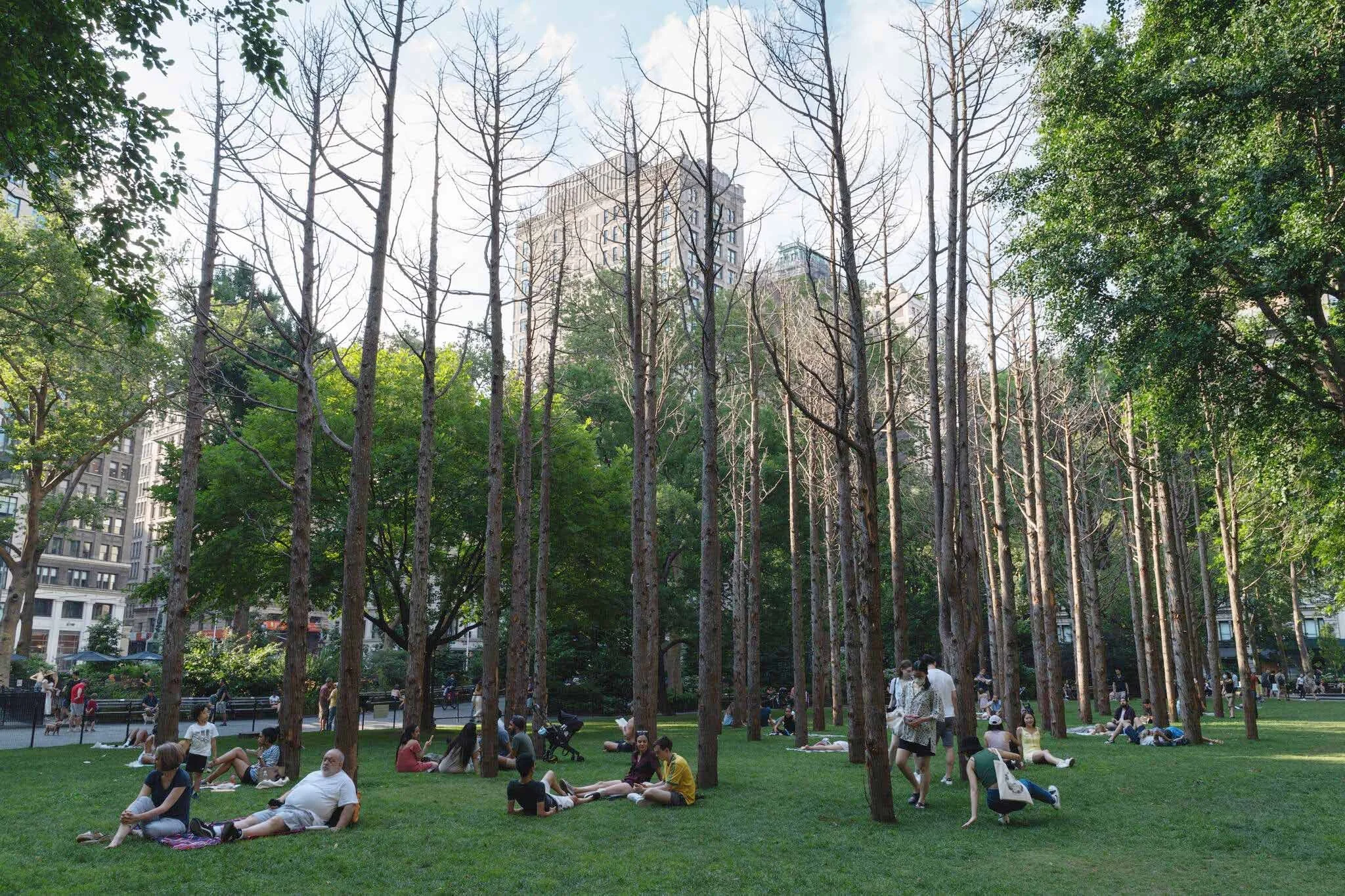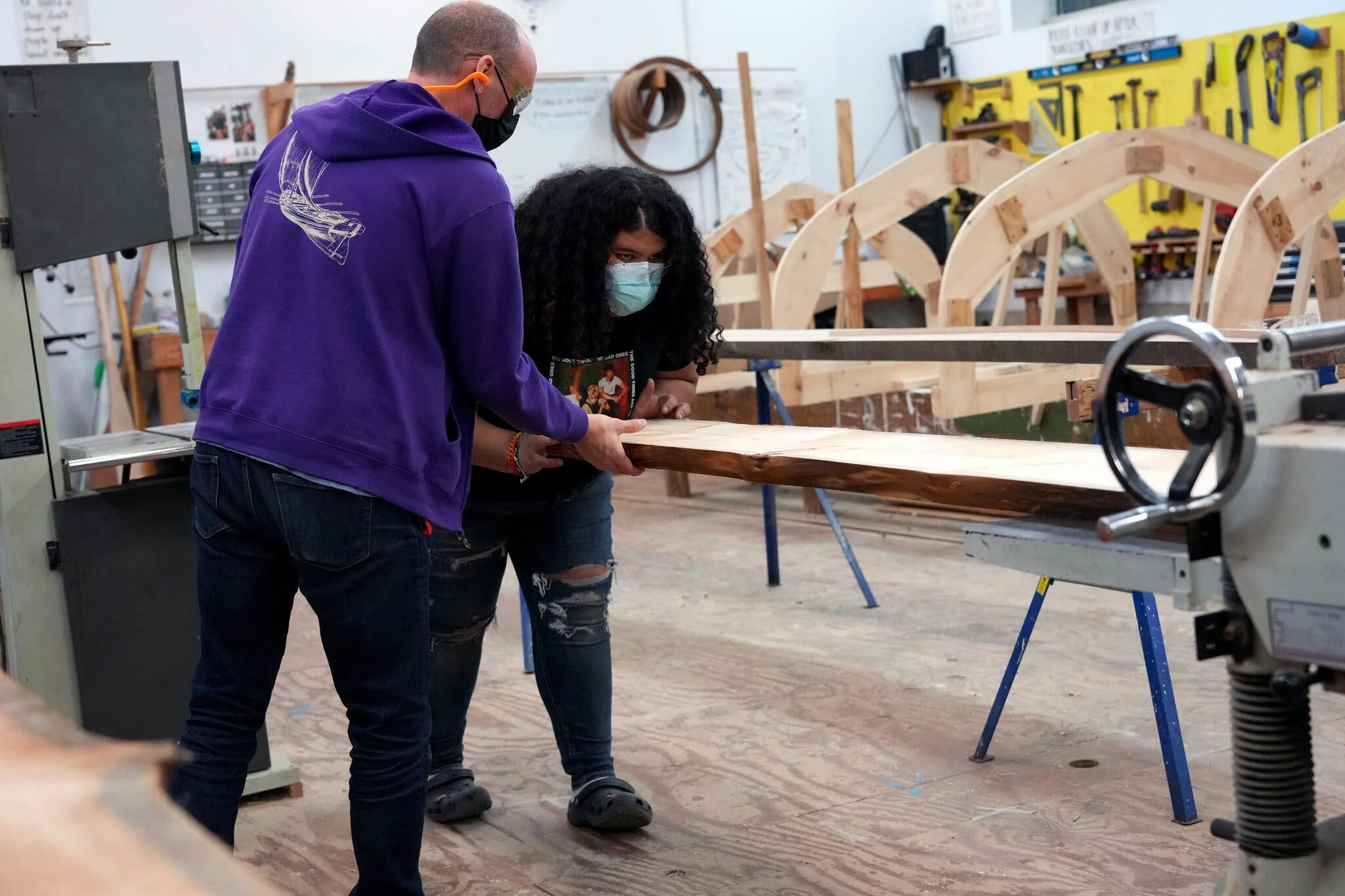Maya Lin’s Dismantled ‘Ghost Forest’ to Be Reborn as Boats
By Zachary Small in the New York Times.
Deborah Simmons, 17, an apprentice, at Rocking the Boat in the South Bronx. “When I’m working on boats, I’m in my happy place,” she said.Credit...Michelle V. Agins/The New York Times
Teenagers are making boats using the wood from her grove installation at Madison Square Park, and the artist is happy that the work is seeing a new life.
Maya Lin’s acclaimed “Ghost Forest” — her installation at Madison Square Park in New York — was being carved up, and the artist couldn’t have been happier: A group of teenagers had seen the harvesting of the wood on Nov. 19 and were sawing it on Monday, to make boats they plan to sail next year.
“I was overjoyed, because otherwise the trees were going to be mulched or turned into shingles,” Lin said in an interview. “The boats are engaging and part of a new life for the artwork.”
Lin had planted 49 trees last spring for the exhibition, which opened in May and drew crowds and critical acclaim with its haunting evocation of environmental apocalypse. The trees, Atlantic white cedars, came from a dying grove that was slated to be cleared as part of a restoration project in the Pine Barrens in New Jersey, where climate change has caused a large swath of forest to die, and with the installation Lin was making a statement about climate change and environmental sustainability.
Maya Lin’s “Ghost Forest” at Madison Square Park, over the summer. “The boats are engaging and part of a new life for the artwork,” she said.Credit...Madeline Cass for The New York Times
Lin knew she wanted to save a portion of each log for future projects, including an outdoor arrangement in Colorado and a virtual work that will coincide with the anniversary of the installation next year. But it was unclear where the rest of the wood would go.
By Monday, remnants of the artwork were on the chopping block of a Bronx wood shop, where teenagers were calling the shots and shaping the planks for boats.
The teenagers acquired the wood through a stroke of luck. Carla Murphy, a programming manager for the New York City Fire Department, was out running through Madison Square Park in October when “Ghost Forest” caught her attention. She stopped dead in her tracks and began listening to the exhibition’s accompanying soundscape. It reminded her of the nature tours that students embark on near the South Bronx with a nonprofit organisation — Rocking the Boat — for which she is a trustee.
Inspiration hit just as Brooke Kamin Rapaport, the park conservancy’s deputy director and chief curator, was passing by. “Hello, I know this is crazy,” Murphy recalled saying. “But I would like to take your trees.”
Crews came out on Friday with a mobile sawmill to fell the trees. The teenagers from the Rocking the Boat program were able to witness this step.Credit...Madison Square Park Conservancy
Rocking the Boat is a nonprofit organisation that teaches students in Hunts Point about the great outdoors by building wooden boats and sailing them. The organisation often sources its wood through donations, and after Murphy asked the Madison Square Park Conservancy about taking the trees, Rapaport and the artist agreed.
The conservancy devoted a portion of its budget to hiring Tri-Lox, a Brooklyn workshop specialising in wood. On Friday, a carpentry crew arrived at the park with a portable sawmill. As they felled the trees and stripped the bark, nearly a dozen students involved with Rocking the Boat watched and learned.
“This is the first time seeing how the trees get harvested,” said Mouctar Barry, 16, from the Hunts Point neighbourhood in the Bronx. He joined the group three years ago for an after school program and grew to love working on boats. Like many of the students, he was unfamiliar with Lin’s work until he learned of her donation. Then he started researching the artist’s other monuments and sculptures.
“It’s interesting how she harvested trees, and now we are using them,” Barry said. “We are giving the trees a new life and a new meaning.”
The situation was certainly unusual for the Madison Square Park Conservancy. “This is the first time an art piece has not left the park in one piece,” said Tom Reidy, the conservancy employee who organised the deinstallation.
A boat building instructor, J. Felix Etcetera, with Jaymi Lopez, planing the wood.Credit...Michelle V. Agins/The New York Times
As the wood went through the mobile sawmill at the park, Rapaport reflected on its long journey and final destination. “The Atlantic white cedar trees have great resiliency,” she said. “They were sourced from a dying forest. They stood in Madison Square Park as symbols and signposts for six months to demonstrate the physical materiality of climate change. And now they are being repurposed with new meaning.”
On Monday, the teenagers were at the work shop.
“We don’t want it to sink,” Joshua Garcia, 17, said as he was describing how he was adding the wood to the 28-foot-boat in front of him. The teenagers would need to scarf and rivet the wood, carefully angling each plank and sealing the frame together with paint. Completing the boat — the first of five using the wood from Lin’s artwork — will take about a year and will have been made by about 20 teenagers.
A boat in progress, at Rocking the Boat. “Our role is connecting the neighborhood to the water,” the organization’s founder, Adam Green, said.Credit...Michelle V. Agins/The New York Times
Rocking the Boat started as a volunteer project in 1995 when its founder, Adam Green, began working with students in an East Harlem junior high school. After migrating uptown to the Bronx a year later, Rocking the Boat developed after school and summer programs that often bring students into nature. The organization also provides social services, academic tutoring and career planning; some participants have gone on to careers in carpentry and marine biology, or have gotten degrees in environmental engineering.
Green said that students start by building the boat’s backbone. The cedar planks are individually shaped and attached to this sort of skeleton until the hull is completed. Strengthening the stem and stern comes next with oak outwales and a ribbed frame providing support. (The rest of the boat is cedar.) The interior is later fitted with floorboards and seats; students also craft their oars by hand and finish the project by naming their boat and decorating it with paint.
By next summer, the boat containing elements of Lin’s artwork will have its maiden voyage, pushed past the salt marsh shores near its launch ramp and into the Bronx River where herons and egrets glide above the water. “The South Bronx is a deeply under-resourced community but has an immense natural resource in the river that can improve people’s lives,” Green said. “Our role is connecting the neighbourhood to the water.”
The teenagers working on the boat this week intend to stick around for that first ride down the river.





